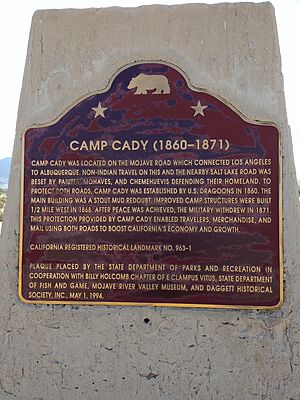Camp Cady facts for kids
Quick facts for kids Camp Cady |
|
|---|---|

Camp Cady Marker
|
|
| Location | 24 Miles N of Barstow, California |
| Built | 1860 |
| Governing body | State of California Department of Fish & Game |
| Designated | March 19, 1985 |
| Reference no. | 963-1 |
| Lua error in Module:Location_map at line 420: attempt to index field 'wikibase' (a nil value). | |
Camp Cady was an important U.S. Army camp that existed from 1860 to 1861 and again from 1866 to 1871. It was located in the Mojave Desert in San Bernardino County, California, about 20 miles east of modern-day Barstow, California. The camp was built along the historic Mojave Road, which was a key travel route. It was named after Major Albemarle Cady, a U.S. Army officer.
Contents
History of Camp Cady
Why Camp Cady Was Built
Camp Cady was first set up in 1860 by Major James Henry Carleton and a group of soldiers called the 1st U.S. Dragoons. This happened during an event known as the Bitter Spring Expedition. The main goal was to create a base camp. From here, soldiers could protect travelers. These travelers were using the Los Angeles - Salt Lake Road. They faced attacks from some Northern Paiute people near a place called Bitter Spring.
Camp Life During the Civil War
After the Bitter Spring Expedition, soldiers were stationed at Camp Cady off and on. The camp was left empty for a while in 1861. This was at the start of the American Civil War. However, California soldiers, known as California Volunteers, sometimes used the camp. They patrolled the area to keep it safe.
Later, in 1863, the U.S. Army returned to the area. They used Camp Cady to guard the Mojave Road. This continued until the Civil War ended.
Protecting Travelers on the Mojave Road
From 1866 to 1871, the U.S. Army kept soldiers at Camp Cady. It was one of several posts along the Mojave Road. Their job was to protect people traveling on the road. They wanted to prevent attacks from local tribes. Once the area was considered peaceful, the camp was finally closed in 1871.
Camp Cady Today
Today, you can still find some old ruins at the site of Camp Cady. There is also a special historical marker. This marker helps people remember the camp's importance. The site is located east of Barstow. It is now part of the Camp Cady Wildlife Area.
California Historical Landmark
Camp Cady is recognized as a California Historical Landmark. Its marker, number 963-1, tells us more about its history:
- NO. 963-1 Camp Cady was located on the Mojave Road which connected Los Angeles to Albuquerque. Non-Indian travel on this and the nearby Salt Lake Road was beset by Paiutes, Mohaves, and Chemehuevis defending their homeland. To protect both roads, Camp Cady was established by U.S. Dragoons in 1860. The main building was a stout mud redoubt. Improved camp structures were built 1/2 mile west in 1868. After peace was achieved, the military withdrew in 1871. This protection provided by Camp Cady enabled travelers, merchandise, and mail using both roads to boost California's economy and growth.
Another marker, number 963, talks about the Mojave Road itself:
- NO. 963 THE MOJAVE ROAD - Long ago, Mohave Indians used a network of pathways to cross the Mojave Desert. In 1826, American trapper Jedediah Smith used their paths and became the first non-Indian to reach the California coast overland from mid-America. The paths were worked into a military wagon road in 1859. This "Mojave Road" remained a major link between Los Angeles and points east until a railway crossed the desert in 1885.


